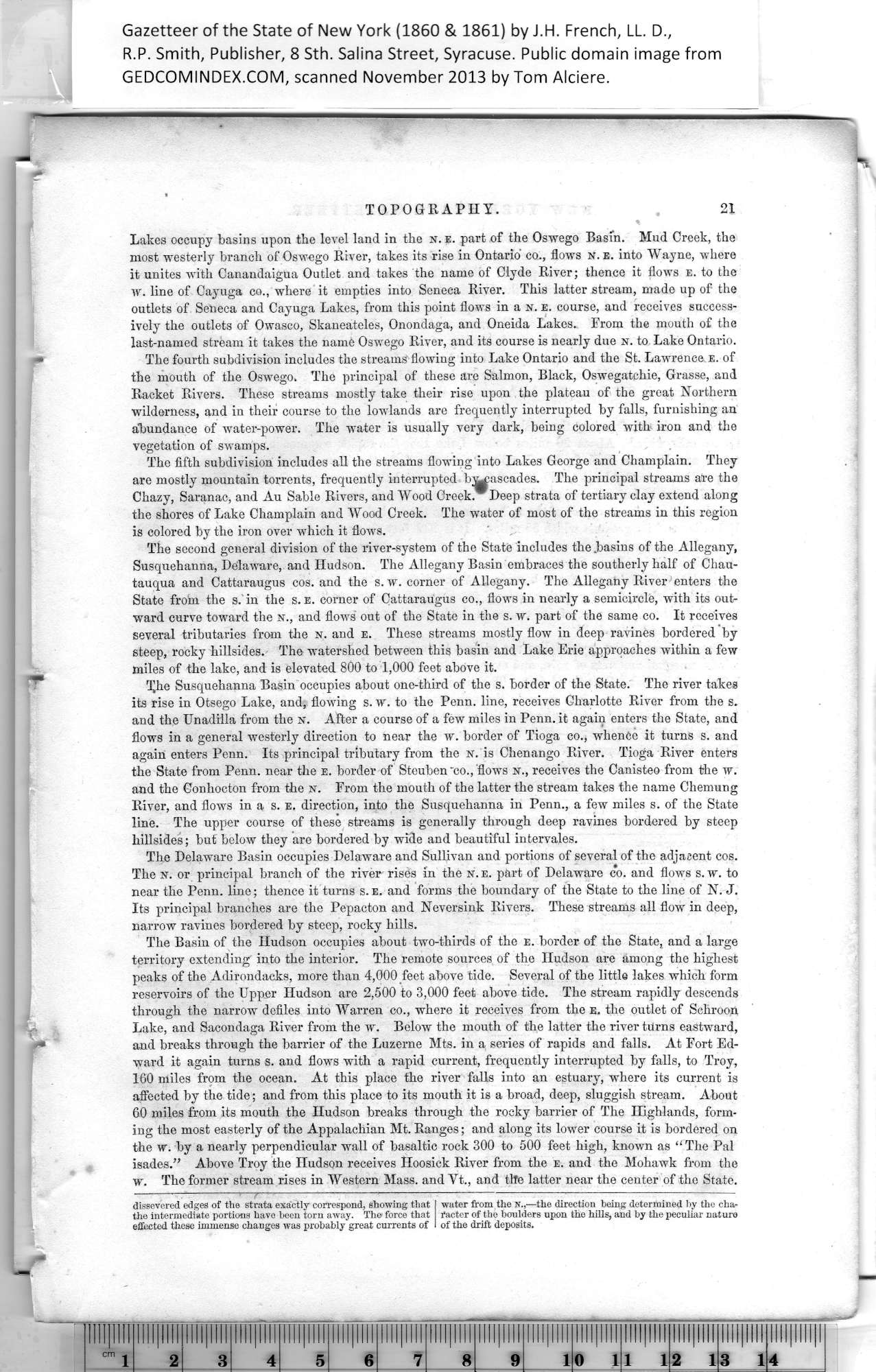|
TOPOGRAPHY. 21
Lakes occupy basins upon the level land in the n. e. part of the Oswego Basin. Mud Creek, the
most westerly branch of Oswego River, takes its rise in Ontario co., flows n. e. into Wayne, where
it unites with Canandaigua Outlet and takes the name of Clyde River; thence it flows e. to the
w. line of Cayuga co., where it empties into Seneca River. This latter stream, made up of the
outlets of Seneca and Cayuga Lakes, from this point flows in a n. e. course, and receives success¬
ively the outlets of Owasco, Skaneateles, Onondaga, and Oneida Lakes. From the mouth of the
last-named stream it takes the name Oswego River, and its course is nearly due n. to Lake Ontario.
The fourth subdivision includes the streams flowing into Lake Ontario and the St. Lawrence e. of
the mouth of the Oswego. The principal of these are Salmon, Black, Oswegatchie, Grasse, and
Racket Rivers. These streams mostly take their rise upon the plateau of the great Northern
wilderness, and in their course to the lowlands are frequently interrupted by falls, furnishing an
abundance of water-power. The water is usually very dark, being colored with iron and the
vegetation of swamps.
The fifth subdivision includes all the streams flowing into Lakes George and Champlain. They
are mostly mountain torrents, frequently interrupted b^pascades. The principal streams are the
Chazy, Saranac, and Au Sable Rivers, and Wood Creek. '"' Deep strata of tertiary clay extend along
the shores of Lake Champlain and Wood Creek. The water of most of the streams in this region
is colored by the iron over which it flows.
The second general division of the river-system of the State includes the .basins of the Allegany,
Susquehanna, Delaware, and Hudson. The Allegany Basin embraces the southerly half of Chau¬
tauqua and Cattaraugus cos. and the s. w. corner of Allegany. The Allegany River enters the
State from the s. in the s. e. corner of Cattaraugus co., flows in nearly a semicircle, with its out¬
ward curve toward the n., and flows out of the State in the s. w. part of the same co. It receives
several tributaries from the n. and e. These streams mostly flow in deep ravines bordered by
steep, rocky hillsides. The watershed between this basin and Lake Erie approaches within a few
miles of the lake, and is elevated 800 to 1,000 feet above it.
The Susquehanna Basin occupies about one-third of the s. border of the State. The river takes
its rise in Otsego Lake, and, flowing s. w. to the Penn, line, receives Charlotte River from the s.
and the Unadilla from the n. After a course of a few miles in Penn, it again enters the State, and
flows in a general westerly direction to near the w. border of Tioga co., whence it turns s. and
again enters Penn. Its principal tributary from the sr. is Chenango River. Tioga River enters
the State from Penn, near the e. border of Steuben “co., flows n., receives the Canisteo from the w.
and the Conhocton from the n. From the mouth of the latter the stream takes the name Chemung
River, and flows in a s. e. direction, into the Susquehanna in Penn., a few miles s. of the State
line. The upper course of these streams is generally through deep ravines bordered by steep
hillsides; but below they are bordered by wide and beautiful intervales.
The Delaware Basin occupies Delaware and Sullivan and portions of several of the adjacent cos.
The sr. or principal branch of the river rises in the n. e. part of Delaware co. and flows s. w. to
near the Penn, line; thence it turns s.e. and forms the boundary of the State to the line of N. J.
Its principal branches are the Pepacton and Neversink Rivers. These streams all flow in deep,
narrow ravines bordered by steep, rocky hills.
The Basin of the Hudson occupies about two-thirds of the e. border of the State, and a large
territory extending into the interior. The remote sources of the Hudson are among the highest
peaks of the Adirondacks, more than 4,000 feet above tide. Several of the little lakes which form
reservoirs of the Upper Hudson are 2,500 to 3,000 feet above tide. The stream rapidly descends
through the narrow defiles into Warren co., where it receives from the e. the outlet of Schroon
Lake, and Sacondaga River from the w. Below the mouth of the latter the river turns eastward,
and breaks through the barrier of the Luzerne Mts. in a series of rapids and falls. At Fort Ed¬
ward it again turns s. and flows with a rapid current, frequently interrupted by falls, to Troy,
160 miles from the ocean. At this place the river falls into an estuary, where its current is
affected by the tide; and from this place to its mouth it is a broad, deep, sluggish stream. About
60 miles from its mouth the Hudson breaks through the rocky barrier of The Highlands, form¬
ing the most easterly of the Appalachian Mt. Ranges; and along its lower course it is bordered on
the w. by a nearly perpendicular wall of basaltic rock 300 to 500 feet high, known as “ The Pal
isades.” Above Troy the Hudson receives Hoosick River from the e. and the Mohawk from the
w. The former stream rises in Western Mass. and Yt., and the latter near the center of the State.
dissevered edges of the strata exactly correspond, showing that I water from the s.,—the direction being determined by the cha-
the intermediate portions have been torn away. The force that racter of the boulders upon the hills, and by the peculiar nature
effected these immense changes was probably great currents of I of the drift deposits.
|
